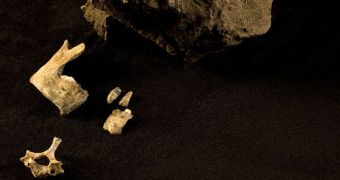The landscape surrounding the city of Johannesburg, South Africa, may have been home to a previously-unknown species of hominids, two new studies show. While conducting archaeological investigations inside the area known as the Cradle of Humankind, researchers stumbled upon a new site, called Malapa, which revealed two remarkably well-preserved skeletons of hominid appearance. The team believes that they belong to a new species of ancestors, which has been dubbed Australopithecus sediba, the US National Science Foundation (NSF) reports.
The two sets of fossilized remains are being described in two scientific papers, both published in the latest issue of the esteemed journal Science. One of the accounts tells the story of the fossils themselves, whereas the other offers a depiction of how the area where the bones were found may have looked like two million years ago. The experts that conducted the related investigations say that the new hominids may represent an intermediary step between the ape-like hominid species Australopithecus and early members of the genus Homo, which eventually developed to include our species, Homo Sapiens, too.
In charge of the international science team that made the remarkable discovery was expert Lee Berger, who is based at the University of Witwatersrand, in South Africa. The Cradle of Humankind, which is classified as a UN World Heritage Site, “is one of the richest fossil sites in Africa, and we want to understand the environment these early hominids lived in. The geologic analysis is also important for directing future efforts to find other fossils,” explains University of California in Santa Cruz (UCSC) earth scientist Daniel Farber. He is also a coauthor of the paper about the ancient landscape.
The experts used a variety of dating techniques to gage the age of the rocks that were found to encase the fossils, and determined that the skeletons are between 1.95 and 1.78 million years old. They may belong to a young male and an adult female, the team reveals. In addition to the two hominids, the researchers also discovered other fossils, including some belonging to saber-tooth cats, hyenas, wild dogs, wild cats, kudus, horses and other smaller animals. This suggests that the cave in which they were hiding suddenly collapsed, preventing predators lurking about from feasting on their corpses.
“We believe the cave originally was deep and only accessible through vertical entrance ways, which made it hard for animals to escape once they became trapped,” Farber says of a possible scenario to explain the findings. The expert's work was funded with grant money from the NSF Division of Earth Sciences. “We are looking at very eroded and denuded portions of this cave system, where nature has exposed what had once been the deep reaches of the caves. People searching for fossils used to look for openings to caves, because they thought the landscape had not changed much, but now we know that cave deposits can be found at the surface,” he concludes.

 14 DAY TRIAL //
14 DAY TRIAL //